Note: This is an extended excerpt from my forthcoming book Words from Hell: Unearthing the darkest secrets of English etymology (Chambers, Oct. 31, 2023).
It may be common knowledge that laser (or L.A.S.E.R.) is an acronym of “light amplification by stimulated emission of radiation.” It was coined around 1960 and modeled after the slightly ealier term maser (M.A.S.E.R.), or “microwave amplification (by) stimulated emission (of) radiation.”
Solid logic.
So you may not be surprised to learn that “Taser,” coined in the 1970s, is aso an acronym—but unlike the prior initialisms, the words “amplification,” “stimulated,” “emission,” and “radiation” are not involved.
Instead, T.A.S.E.R. stands for “Tom A. Swift’s electric rifle.”
This rifle is a fictional weapon wielded by the character Tom Swift, who made his novel debut in 1910.
Tom was created by children’s fiction author Edward L. Stratemeyer, who remains one of the most prolific writers in history, having written more than 1,300 books himself and publishing many more through his company, somewhat ominously called the Stratemeyer Syndicate.
Stratemeyer was, without exaggeration, a fiction content tycoon.
A profile of him in Fortune magazine purportedly read “As oil had its Rockefeller, literature had its Stratemeyer.” (Note: I have not successfully located an original version of this article, only references to it in other online sources.)
He began publishing books in the 1880s and in his lifetime became one of the first people to capitalize on the concept of the modern day fiction franchise — more or less creating a Marvel Cinematic Universe, but with precocious and genre-specific teens and tweens.
Even if you don’t know Stratemeyer’s name, you may have at least heard of his characters, which included The Hardy Boys, Nancy Drew, The Bobbsey Twins and, of course, Tom Swift.
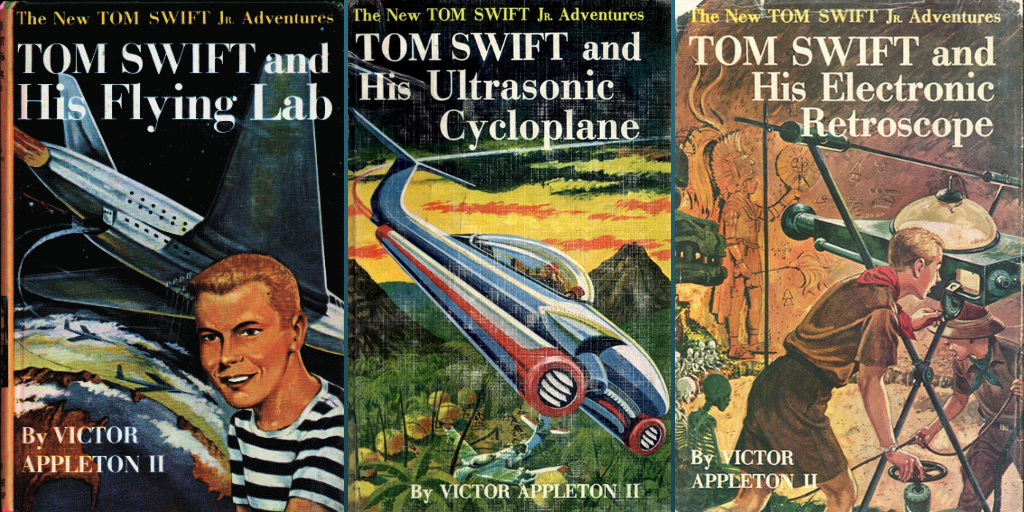
Tom Swift, a teenage genius and inventor, was created by Stratemeyer, though the 40 books in the original series were produced by multiple ghostwriters under the pseudonym Victor Appleton until the early 1940s.
In this book series, Tom Swift is a teenage genius and inventor whose creations often reflect the latest innovations of the day and are, of course, used to thwart his ill-intended enemies. Each book focuses on one of his inventions, such as Tom Swift and His Flying Lab or Tom Swift and His Giant Telescope. (Evidently the latter is not intentionally phallic.)
Tom Swift and his fictional adventures also inspired a number of real 20th-century inventors including Jack Cover (1920–2009), the NASA researcher who developed the Taser in 1974 and named it after one of the character’s inventions.
Tom doesn’t have a middle name in the book series, so Cover originally named it the “T.S.E.R.” but added the A to cement the acronym and reflect terms such as “laser.” The real-world device was originally sold by the company Taser International, which is now Axon.
But wait—there’s a more problematic side to this story:
The book the word “Taser” is based on is called Tom Swift and His Electric Rifle, or Daring Adventures in Elephant Land, published in 1911—and it is breathtakingly racist, and comes with a side of elephant slaughter.
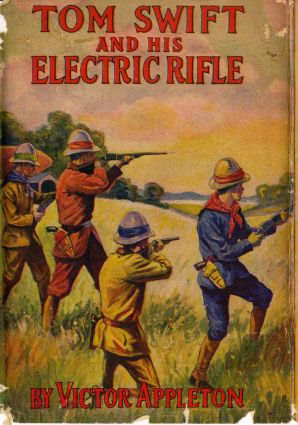
In this novel, Tom goes on an adventure to Africa to slaughter dozens of elephants for their ivory using his electric rifle.
We’re already off to a distressing start, but it gets worse.
Along the way, Tom and his group of primarily white companions meet many indigenous Africans, including Black African people and people whom the book calls “red pygmies,” both of whom are depicted as animal-like and uncivilized.
At one point a group of African people is described as “tall, gaunt black men, hideous in their savagery, wearing only the loin cloth, and with their kinky hair stuck full of sticks, bones and other odd objects they presented a curious sight,” while the so-called “red pygmies” are variously called “imps,” “fiends,” and “dwarfs.”
The narrative is stuffed with “white savior” tropes and racist stereotypes, and describes the white characters outright shooting, not just the elephants, but also the indigenous characters with the electric rifle and other firearms.
The following is a passage about the people who are most frequently called “red pygmies” in the text:
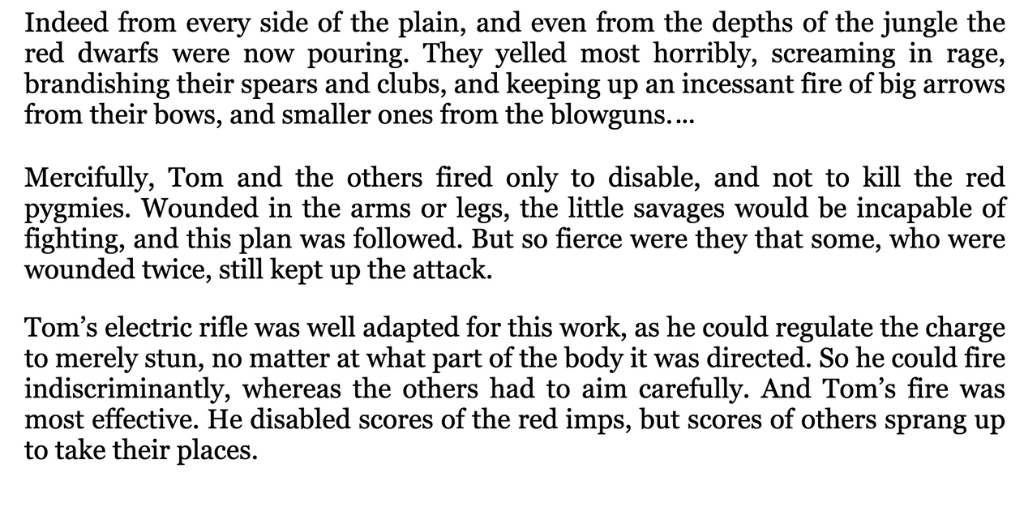
(That word “mercifully” is doing a lot of work here.)
The one non-white person in their party is a servant named Tomba, who is a disaster of racist stereotypes:

And there’s far more alarming language—plus heaps of dead elephants—to be found in the pages of Tom Swift and His Electric Rifle, namesake of the Taser: You can, if you wish, read the full text on Gutenberg.org.
While the acronym doesn’t directly reference these tropes, it’s certainly connected to the novel, a fact that infuses this weapon’s name with a startling and disturbing history.
Read more alarming facts about everyday words in Words from Hell.

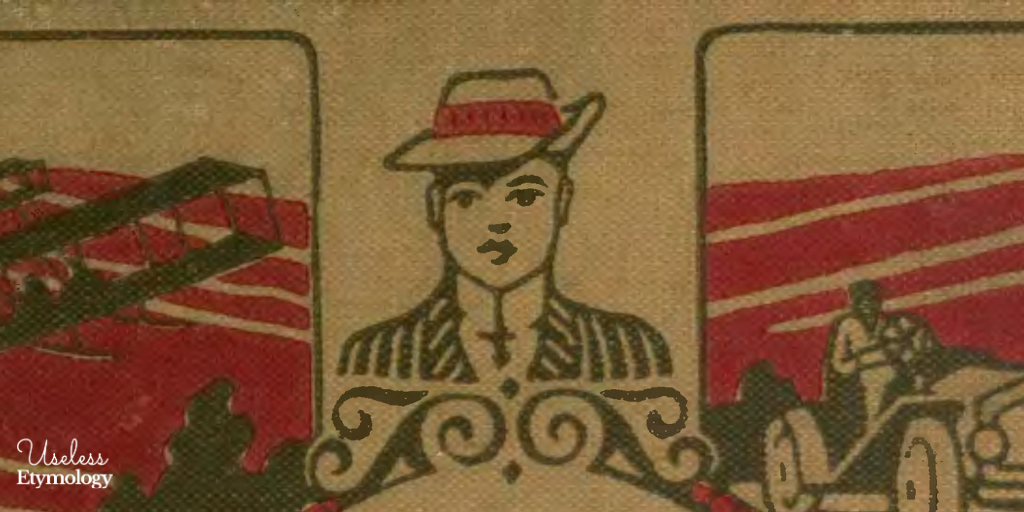
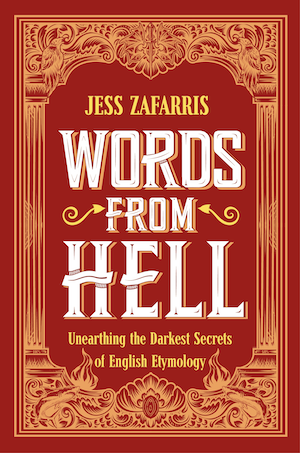
Thank you for this post. Perhaps it’s no coincidence that according to a 2020 study, when tasers are used by US police and “when those encounters have turned fatal, black people make up a disproportionate share of those who die, according to a Reuters analysis.
“Reuters documented 1,081 cases through the end of 2018 in which people died after being shocked by police with a Taser, the vast majority of them after 2000. At least 32% of those who died were black, and at least 29% were white. African-Americans make up 14% of the U.S. population, and non-Hispanic whites 60%.”
LikeLike
Absolutely. Sobering numbers.
LikeLike